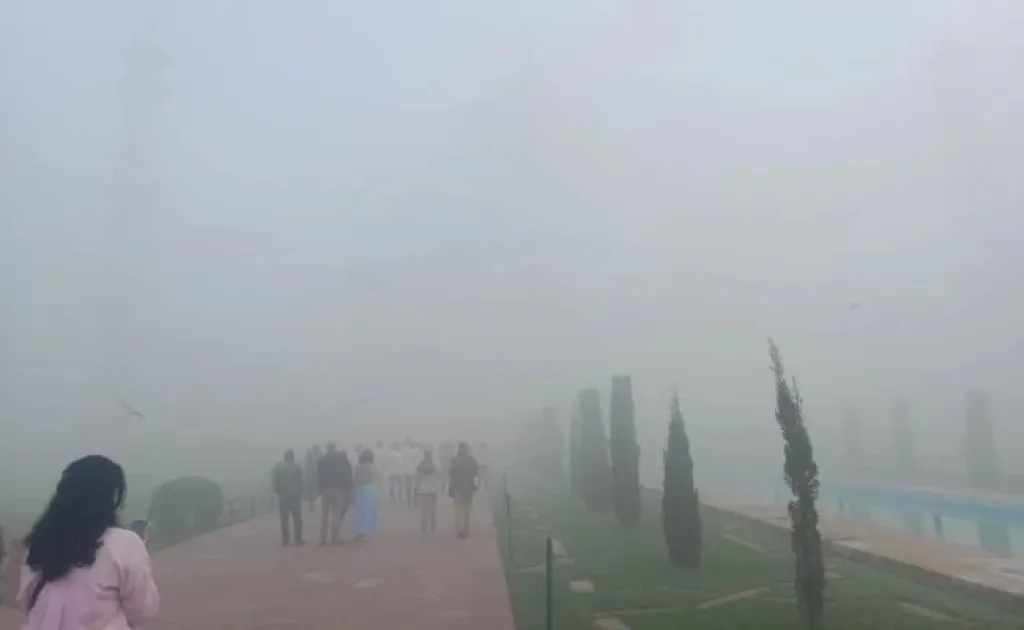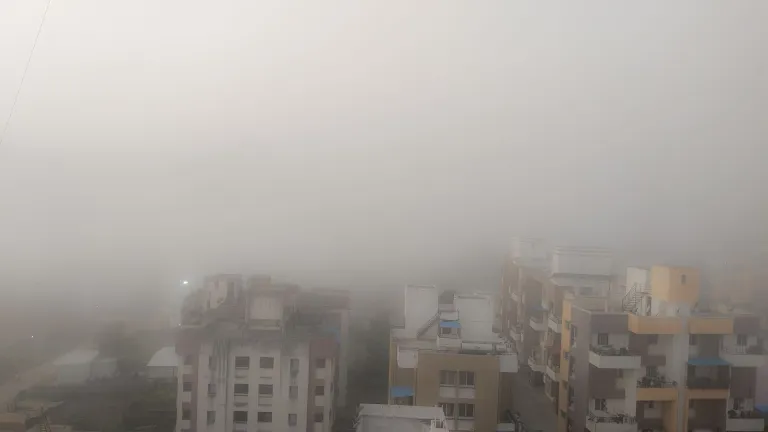Taj Mahal Disappears in Smog as Air Pollution in Agra Surges

A dense smog has nearly hidden the iconic Taj Mahal from view, as rising air pollution blankets Agra and much of northern India. With worsening air quality, tourists and residents face poor visibility and health concerns, highlighting a growing environmental crisis in the region.
Taj Mahal Nearly Invisible Amid Rising Pollution
Agra’s famed Taj Mahal, one of the most iconic monuments in the world, vanished behind a thick layer of smog on Thursday, as rising pollution levels drastically reduced visibility. The hazy scene left visitors disappointed, with many snapping photos of the Taj Mahal almost invisible against the dense fog. Agra’s air quality index (AQI) hit 193 on the Central Pollution Control Board (CPCB) scale, categorizing it as ‘moderate’. However, this smoggy blanket blurred the architectural marvel, underscoring the health risks that come with deteriorating air quality in India’s northern regions.
The spike in pollutants has been attributed primarily to high levels of PM 2.5 particles, one of the most harmful air pollutants, and a significant increase in moisture levels. The India Meteorological Department (IMD) reported that Agra's minimum temperature on Thursday was 17 degrees Celsius, with highs expected to reach 30 degrees Celsius. Forecasts predict continued fog or mist for several days, with dense fog likely persisting until Monday, affecting both residents and the throngs of tourists who journey here from around the globe to catch a glimpse of this UNESCO World Heritage site.
Also read: Exploring Delhi's Famous Cuisine: A Food Lover's Guide
Delhi Faces 'Severe' Pollution Levels as Fog and Smog Persist

Stubble burning in neighboring areas has also worsened air quality, causing PM 2.5 levels to rise and blanketing regions like Agra and Delhi in smog. This phenomenon has impacted Delhi even more severely, with some areas recording AQI levels as high as 466 – classified as ‘severe’ – since Wednesday. In response, the Delhi airport has introduced low-visibility protocols, with authorities advising passengers to stay updated on flight schedules.
Delhi’s Environment Minister, Gopal Rai, acknowledged the poor conditions and expressed hope that weather changes in the coming days might bring some relief. Meanwhile, tourists visiting the Taj Mahal, who often plan their trips well in advance to experience the monument’s beauty, are finding themselves surrounded by a thick haze rather than the iconic views they had envisioned.
Also read: Delhi International Airport to Get Air Trains by 2027 - India's First Ever!
Tourism Impacted as North India’s Air Quality Worsens
With winter approaching, residents and tourists alike are left grappling with the intensifying pollution levels across northern India, raising urgent questions about air quality and public health as they await clearer skies.
Published at
About Author
Subscribe our Newsletter
Get our weekly tips and travel news!
Related Posts
10 Most Searched Places in India By Foreign Travellers
Discover India's most popular tourist destinations! From the Taj Mahal to the Himalayas, explore the top 10 places foreign travelers love.
11 New Eco-Tourism Spots Coming to Himachal Pradesh
In a bid to promote sustainable tourism and showcase the pristine beauty of the state, the Himachal Pradesh government has identified 11 new eco-tourism sites.
17 y/o Makes Fake Flights Bomb Threats to 'Frame a Friend' - Leads to Flights Disruptions
Over 19 hoax bomb threats disrupt flights across India, causing massive delays and diversions...
200 Free Highway Trips? FASTag Makes It Possible
Say goodbye to endless toll stops! FASTag’s Annual Pass offers 200 free trips and faster travel.
Embark on a flavorful odyssey through the global gastronomic tapestry as we unveil three Indian restaurants adorned with rich flavors and cultural influences, securing their spot among the world's top 10 legendary dining destinations.
Latest Posts
5 rooftop NYE Celebrations in mumbai with sea views
5 ultimate Mumbai rooftop parties for NYE! Celebrate with luxury, fireworks, and the best views of the Arabian Sea.
5 Living Root Bridge Villages in Meghalaya You Can Stay
Stay inside Meghalaya’s living root bridge villages, where the bridges grow, the forests breathe, and every path feels alive.
7 Bakeries in Kolkata Famous for Christmas Plum Cakes
Celebrate Kolkata’s Christmas with plum cakes from iconic spots like Nahoum’s, Flurys, and more.
Goa Calling! 7 Affordable New Year's Parties Under ₹5000 Entry
Get ready for a budget-friendly New Year's Eve! 7 best parties in Goa under ₹5000 entry. Dance, rave, or cruise!
5 Bamboo Cottages in Assam with Tea Estate Views Under ₹3500
Discover five charming bamboo cottages in Assam under ₹3500, offering tea estate views, rustic comfort, and immersive stays surrounded by serene green landscapes.

